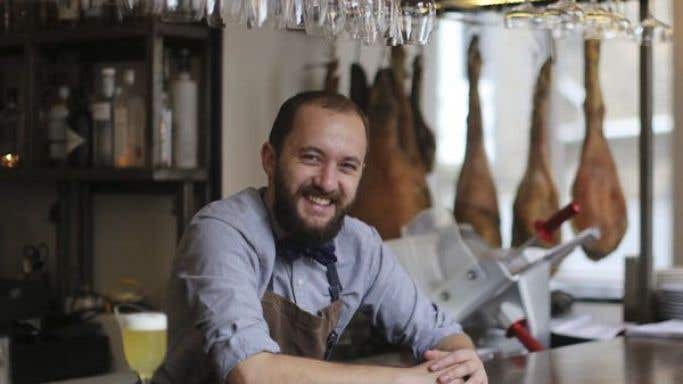This is a version of an article also published by the Financial Times.
Although the style and service of food have changed fundamentally since restaurants first emerged in Paris in the second half of the 18th century, the names and titles of those who work in restaurants have barely altered. The words chef, commis waiter, sommelier, maître d’ and restaurateur are as recognisable today as they were then.
But recently a new role, and with it a new title, has emerged. The name is perforce a hybrid – bar chef – but it is one that is having a very beneficial effect on how customers are made welcome in new, exciting bars and restaurants around the world.
The easiest way of describing what a talented bar chef does is to describe how, in contrast, bartenders used to work with the kitchen. This interaction was limited to the provision of the fruit, principally lemons, oranges, limes and the odd stick of celery, that bartenders required to finish off their cocktails and the supply, in return, of coffee to keep the chefs on their toes.
Today, a bar chef will make use of many of the kitchen’s tools for his cocktails. He will raid the kitchen’s dry goods store for spices and herbs, and he will take advantage of what the kitchen is producing as base material for new cocktails that are as yet works in progress.
There are several reasons for the emergence of bar chefs. The first is, as with the presence today of so many baristas, the sheer enthusiasm on the part of those making this new profession their own. The second is that a lot of this is happening in much smaller locations, an environment forcing bar chefs and those in the kitchen to work physically much closer together than before. The bar is also, invariably, the welcome point of any restaurant so writing an individually expressive cocktail list, which the customer sees even before the menu, is an appropriate way to set the artistic tone. Finally, these cocktails are fun and good for business.
The Clove Club in Shoreditch, east London, may be housed in the old town hall built in 1865 but the ingredients in its signature cocktails are very modern. Kamm & Sunrise is a botanical spirit distilled in north London blended with rhubarb and grapefruit. Give Bees A Chance incorporates honey, lemon, egg white and vodka, while the non-alcoholic Smoke, No Fire includes smoked citrus, the result of lemons processed through the kitchen’s smoker, a piece of equipment previously reserved for smoking fish and meat.
Rob Simpson, the bar chef responsible for these cocktails, looks every inch the part. He is 30, bearded (of course), wears a flat cap and is incredibly passionate about his profession. Like so many bar chefs, he calls what he serves his cocktails in not glasses but vessels.
He began his disquisition on the bar chef’s role by explaining that the bar was an adjunct of the restaurant, that customers come here to eat rather than to drink, and that the restaurant’s location means that he cannot charge too much for his cocktails. All reasons, in his opinion, to take advantage of whatever the chefs in the creative kitchen in the basement can make available.
Chefs’ toys are an obvious source, and Simpson grabbed a Cream Profi Whip from a passing chef. ‘Every kitchen has one of these to add a foamy texture to their desserts. It works just as well for cocktails and I also use it for rapidly infusing vodka for spicy cocktails. It ruptures the cell linings of aromatics and forces the alcohol in so the infusion can take minutes not hours or days.’
Other shared tools range from the common blender to the more esoteric dehydrator, an expensive piece of kit that dries out and therefore intensifies the flavours of whatever has spent some time inside it. Limes that had been treated in this way for 2-3 days emerged blackened but full of flavour and ideal as lime dust to line the glass of an otherwise classic pisco sour. Simpson also cited the poaching liquor that the kitchen had left over from dealing with batches of peaches, apricots and rhubarb. This is bottled in two-litre batches and then used to infuse cocktails and iced teas.
There was also the potential to put the same ingredients to very different effect in both the bar and the kitchen. They had just received a large delivery of this autumn’s wet walnuts: half had gone to the kitchen to be converted into vinegars and syrups while the other half had gone to the bar and will emerge eventually as the flavouring for liqueurs.
Simpson then showed me their £65 tasting menu that ended with a dish that reveals the benefit of such synergy. This was a blackcurrant-leaf ice cream with blackcurrant jelly, an ice cream infused with a blackcurrant wine Simpson made by immersing blackcurrant leaves, surplus to the kitchen’s requirements, in red wine, alcohol and sugar.
Simpson is fascinated by non-alcoholic cocktails and in particular the creation of a non-alcoholic negroni, the flavour of which attracts so many despite its kick. He would like to write his cocktail list so that it chimes more subtly with the seasonality that the kitchen aims for. And his professional holy grail is the creation of a cocktail that has the flavour of a fig roll, a personal favourite.
Bar chefs are here to stay.
The Clove Club Shoreditch Town Hall, 380 Old Street, London EC1V 9LT; tel +44 (0)20 7729 6496

